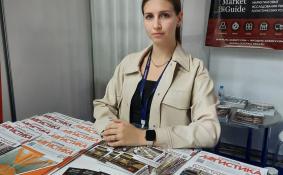
научно-практический
журнал

Новости редакции
18 ноября Президент Российского Союза химиков Виктор Иванов лично вручил директору «Агентства Маркет Гайд» и издателю журнала «ЛОГИСТИКА» Юлии Кисловой сертификат, подтверждающий членство агентства в Российском Союзе химиков.
Дорогие читатели! Десятый номер журнала «Логистика» открывается большим материалом, посвященным итогам Делового форума БРИКС, прошедшем 18 октября 2024 г. в Москве. Директор ООО «Агентство Маркет Гайд» и издатель журнала «ЛОГИСТИКА» Юлия Кислова побывала на мероприятии и подготовила статью, где особое внимание уделила международной торговле и логистической связанности стран объединения. Подробности – в номере.
Директор ООО «Агентство Маркет Гайд» и издатель журнала «ЛОГИСТИКА» Юлия Кислова посетила форум «Международный день торговли – 2024», который прошел 7 ноября 2024 г. в Москве, в Торгово-промышленной палате Российской Федерации. Основной темой форума стало международное сотрудничество и межрегиональная кооперация. Организатором форума выступила Ассоциация экспортеров и импортеров.
Статья недели:

ФОТО НЕДЕЛИ
ЦИТАТЫ
События в российской логистике
London is world’s most expensive office market for second straight year
Hong Kong and Beijing Markets Claim Four of Top Five Most Expensive Market Spots
Global Prime Office Occupancy Costs Up 2.4 Percent Year-Over-Year As Rents Rise in U.S. and EMEA Markets
Los Angeles - Moscow, 23 December 2015, — London’s West End was the world’s highest-priced office market for the second straight year and Hong Kong Central, Beijing Finance Street Beijing Central Business District and Hong Kong West Kowloon, took four of the top five most expensive spots in the rankings, according to CBRE Research’s semi-annual Global Prime Office Occupancy Costs survey.
London’s West End topped the “most expensive” list, with overall prime occupancy costs of US$273 per sq. ft. per year. Hong Kong (Central) followed, with prime occupancy costs of US$269 per sq. ft. Beijing (Finance Street), at US$191 per sq. ft., Beijing (Central Business District (CBD), at US$183 per sq. ft., and Hong Kong (West Kowloon), at US$162 per sq. ft., rounded out the top five.
Prime occupancy costs—which reflect rent, plus local taxes and service charges—increased at a 2.4 percent annual pace globally, as the world economy continued to gradually improve and the service sector, a key bellwether for prime office space, entered its fourth year of expansion, driving healthy demand for space in top-quality properties.
In the Americas, prime occupancy costs increased by 3.1 percent year-over-year, largely thanks to the U.S., where rising office-using employment growth stimulated demand for commercial real estate nationwide, including in some key non-gateway and suburban markets.
Prime occupancy costs in EMEA rose 2.2 percent following economic recovery, while costs in Asia Pacific increased by 1.9 percent.
“The global services sector has grown steadily for four years now, which helps to explain the general uplift in office rents and costs we are seeing worldwide,” said Richard Barkham, global chief economist, CBRE. “Despite the fact that some markets have been hit by the China, oil and commodities slowdowns, we expect that most advanced economies will keep growing in 2016 and 2017, which combined with limited availability and relatively muted development levels, will result in moderate 2 percent to 3 percent cost increases.”
CBRE tracks occupancy costs for prime office space in 126 markets around the globe. Of the top 50 “most expensive” markets, 19 were in EMEA, 20 were in Asia Pacific and 11 were in the Americas.
Europe Middle East & Africa (EMEA)
Thirty-three markets in EMEA notched increases in occupancy costs as the region’s economic recovery continued to take hold, with 65 percent of European markets moving up by more than three places in the rankings.
Four of the rising markets—Prague, Warsaw, Bucharest, Belgrade—were in Central Europe, which has performed better because of the pick-up in the Eurozone and the benefits it offers in terms of a low-cost location for manufacturing and service sector activity.
Office rent values also significantly increased in several U.K. regional cities, including Manchester, Leeds, Liverpool, Southampton and Belfast, providing evidence of an increasingly positive supply-demand balance for U.K. markets outside London.
Claudia Chistova, Head of Research Department in CBRE, Russia, said:
“By the end of 2015 Moscow has lost its position in the world’s ten most expensive cities and dropped to number 11. Though at the end of 2014 Moscow had the 5th position in the ranking. This is a result of further rents decrease. Prime class A rents went down by 10% during 2015 or by 15-25% compared to the beginning of 2014. Currently, prime class A rents are $800-900 net of OpEx and VAT. Offices in the prime A market segment are under pressure due to the extremely limited level of demand for such space. During three quarters of 2015 the total volume of new lease deals done in the prime class A segment accounted for 20,000 sq m (4% of the total volume of new leases in Moscow), the volume of lease renewals and renegotiations totaled 64,000 sq m (16 % of the total). As a general trend in Moscow office market companies prefer to fix better commercial terms for the short term in their existing business centres. This is largely due to the fact that the end of the crisis is not obvious and it is difficult for companies to plan their future business development.”
Asia Pacific
Asia Pacific was home to seven of the top 10 most expensive markets globally—Hong Kong (Central), Beijing (Finance Street), Beijing (CBD), Hong Kong (West Kowloon), New Delhi (Connaught Place - CBD), Tokyo (Marunouchi Otemachi) and Shanghai (Pudong).
Shanghai (Pudong) moved into the top 10 globally, rising two places to the ninth spot. Despite the Chinese economic slowdown, demand from financial services firms for prime space in Pudong remains strong and supply remains limited.
Hong Kong (Central) remained the only market in the world—other than London’s West End—with a prime occupancy cost exceeding US$200 per sq. ft. However, there is some evidence that overseas financial services companies are resistant to continued high costs and may be seeking alternative to a Hong Kong location.
Americas
New York (Midtown) retained its spot in 10th place and remained the most expensive Americas market, with a prime office occupancy cost of US$127 per sq. ft.
Tech-focused markets continued to fare well, with Seattle (Downtown) topping the global list of increases in occupancy costs, up 17.3 percent year-over-year, and prime costs continuing to rise in San Francisco despite an increase in the supply of Class A product.
Prime occupancy costs grew in a host of key cities and suburban markets—including Washington, D.C. (Downtown), San Francisco (Peninsula), Seattle (Downtown), Seattle (Suburban), Atlanta (Downtown) and Atlanta (Suburban)—evidencing the growing breadth and depth of the recovery of the office market in the U.S.
In Latin America, Lima, Monterrey, Buenos Aires and Mexico City rose up the ranks, showing that the troubles being felt by Brazil are not typical of the whole region.











